power steering PONTIAC BONNEVILLE 1996 Owners Manual
[x] Cancel search | Manufacturer: PONTIAC, Model Year: 1996, Model line: BONNEVILLE, Model: PONTIAC BONNEVILLE 1996Pages: 387, PDF Size: 18.71 MB
Page 68 of 387
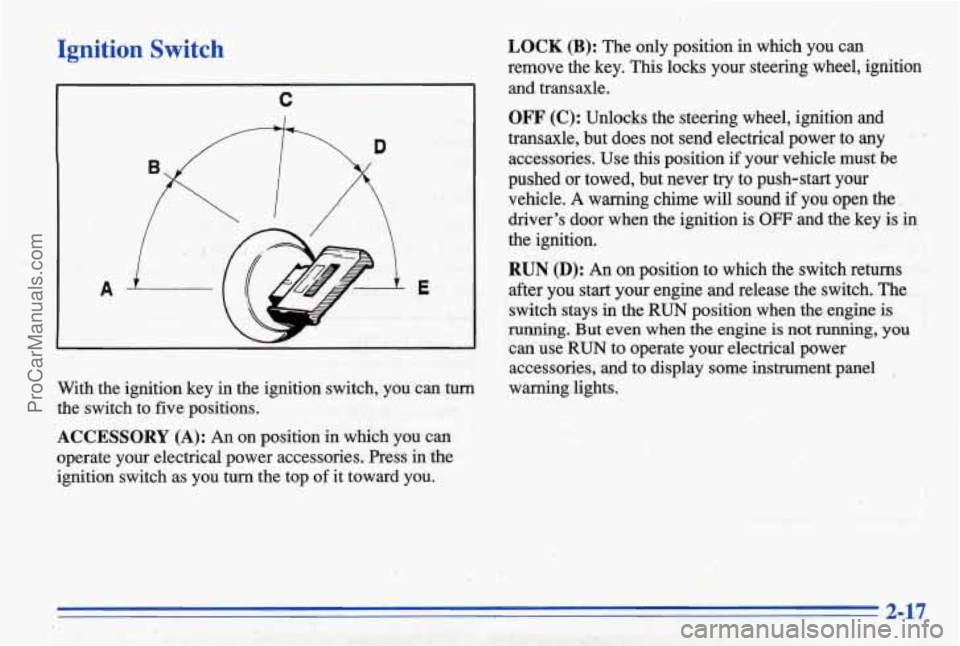
Ignition Switch
C
With the ignition key in the ignition switch, you can turn
the switch to five positions.
ACCESSORY (A): An on position in which you can
operate your electrical power accessories. Press in the
ignition switch
as you turn the top of it toward you.
LOCK (B): The only position in which you can
remove the key. This locks your steering wheel, ignition
and transaxle.
OFF (C): Unlocks the steering wheel, ignition and
transaxle, but does not send electrical power to any
accessories.
Use this position if yoUr vehicle must be
pushed or towed, but never try to push-start your
vehicle.
A warning chime will sound if you open the,.
driver's door when the ignition is
OFF and the key is in
the ignition.
RUN (D): An on position to which the switch returns
after you start your engine and release the switch. The
switch stays
in the 'RUN position when the engine is
running. But even when the engine is not running, you
can use RUN to operate your electrical power
accessories,
and to display some instrument panel
warning lights.
2-17
ProCarManuals.com
Page 69 of 387
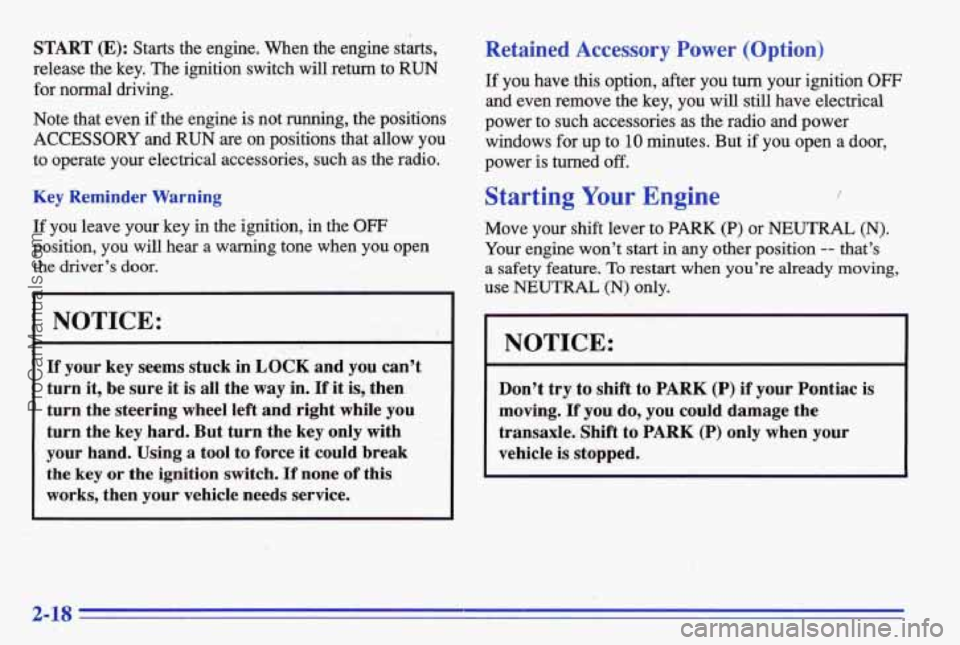
START (E): Starts the engine. When the engine st&&
release the key. The ignition switch
will return to RUN
for normal driving.
Note that even if the engine
is not running, the positions
ACCESSORY and RUN are on positions that allow you
to operate your electrical accessories, such as the radio.
Key Reminder Warning
If you leave your key in the ignition, in the OFF
position, you will hear a warning tone when you open
the driver’s door.
NOTICE:
If your key seem stuck in LOCK and you can’t
turn it, be sure
it is all the way in. If it is, then
turn the steering wheel left and right while you
turn the key hard. But turn the
key only with
your hand. Using a tool to force it could break
the key or the ignition switch.
If none of this
works, then your vehicle needs service.
Retained Accessory, Power (Option)
If you have this option, after you turn your ignition OFF
and even remove the key, you will still have electrical
power to such accessories
as the radio and power
windows for up to 10 minutes. But if you open a door,
power is turned off.
Starting Your ,Engine
Move your shift lever to PARK (P) or NEUTRAL (N).
Your engine won’t start in any other position -- that’s
a safety feature. To restart when you’re already ‘moving,
use NEUTRAL (N) only.
NOTICE:
Don’t try to shift to PARK (P) if y& Ponthc is
moving. If you do, you could damage the
transaxle. Shift to PARK (P) only when your
vehicle
is stopped.
2-18
ProCarManuals.com
Page 176 of 387
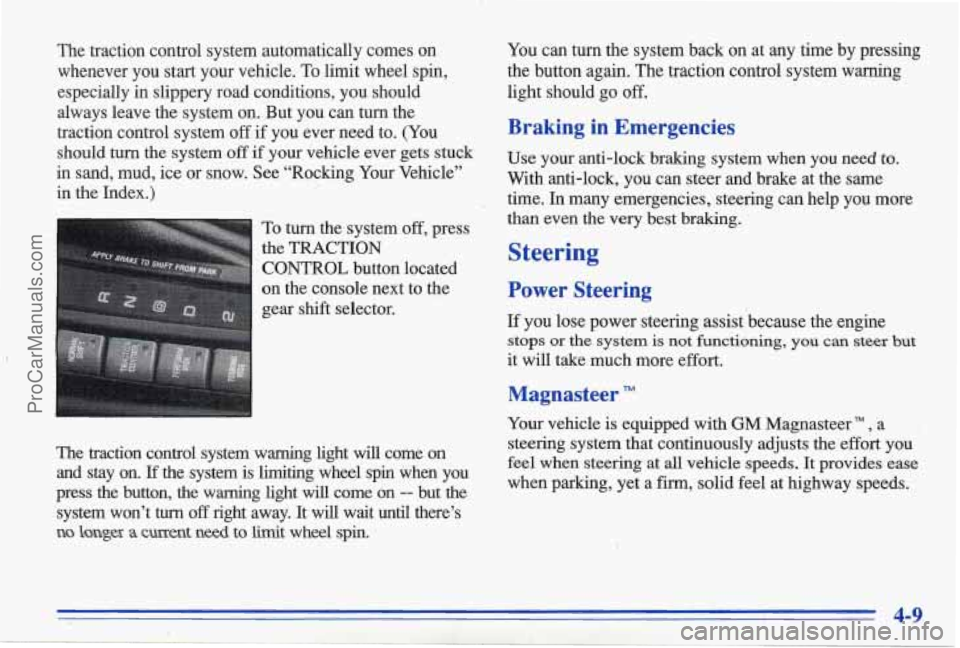
The traction control system automatically comes on whenever you start your vehicle. To limit wheel spin,
especially in slippery road conditions, you should
always leave the system on. But you can turn the
traction control system off if you ever need to. (You
should
turn the system off if your vehicle ever gets stuck
in sand, mud, ice or snow. See “Rocking Your Vehicle”
in the Index.)
To turn the system off, press
the
TRACTION
CONTROL button located
on the console next to the
gear shift selector.
I I
The traction control system warning light will come on
and stay on. If the system is limiting wheel spin when you
press
the button, the warning light will come on -- but the
system won’t
turn off right away. It will wait until there’s
no longex a current need to limit wheel spin.
You can turn the system back on at any time by pressing
the button again. The traction control system warning
light should
go off.
Braking in Emergencies
Use your anti-lock braking system when you need to.
With anti-lock, you can steer and brake at the same
time. In many emergencies, steering can help you more
than even
the very best braking.
Steering
Power Steering
If you lose power steering assist because the engine
stops or the system. is not functioning, you can steer but
it will take much more effort.
Magnasteer
Your vehicle is equipped with GM Magnasteer TM , a
steering system that continuously adjusts the effort you
feel when steering.at all vehicle speeds. It provides ease
when parking, yet a firm, solid feel at highway speeds.
4-9
ProCarManuals.com
Page 257 of 387
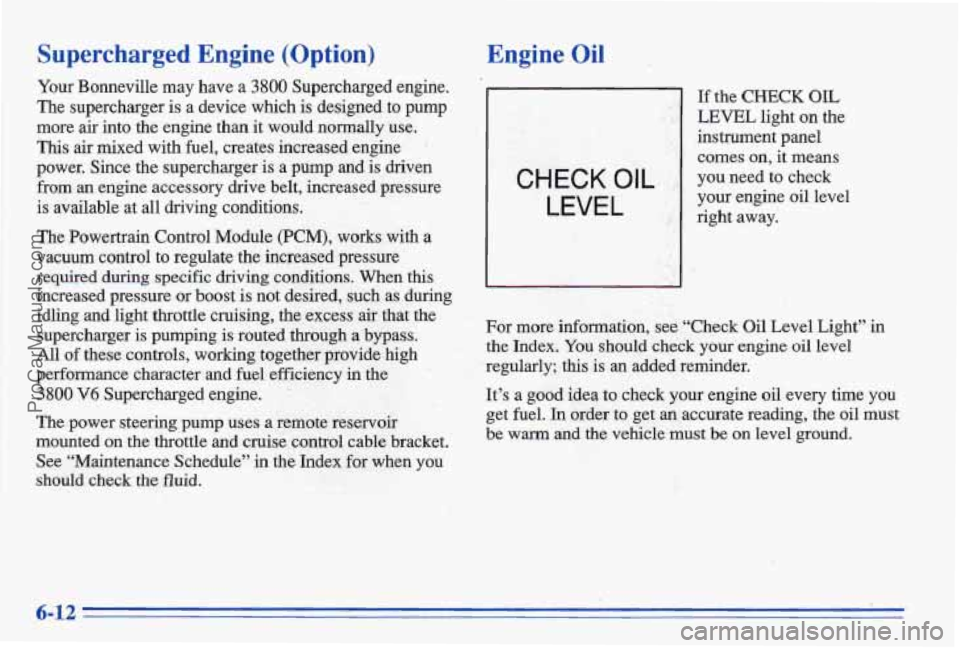
Supercharged Engine (Option)
Your Bonneville may have a 3800 Supercharged engine.
The supercharger is a device which is designed
to pump
more
air into the engine than it would normally use.
This air mixed with fuel, creates increased engine
power. Since the supercharger is a pump
and is driven
from an engine accessory drive belt, increased pressure
is available at all driving conditions.
The Powertrain Control Module (PCM), works with a
vacuum control to regulate the increased pressure
required
during specific driving conditions. When this
increased pressure or boost is not desired, such as during
idling
and light throttle cruising, the excess air that the
supercharger is pumping is routed through
a bypass.
All of these controls, working together provide high
performance character
and fuel efficiency in the
38010 V6 Supercharged engine.
The-power steering pump uses a remote reservoir
mounted on the throttle and cruise control cable bracket.
See “Maintenance Schedule”
in the Index for when you
should check the fluid.
I ’. .. ,- .. .. , . -. :? 1
Engine Oil
CHECK OIL
LEVEL
If the CHECK OIL
LEVEL light on the
instrument panel comes
on, it means
you need to check
your engine oil level
right away.
For more information, see “Check Oil Level Light”
in
the Index. You should check your engine oil level
regularly; this is
an added reminder.
It’s a good idea
to check your engine oil every time you
get fuel. In order to get an accurate reading, the oil must
be warm and the vehicle must be on level ground.
6-12
ProCarManuals.com
Page 271 of 387
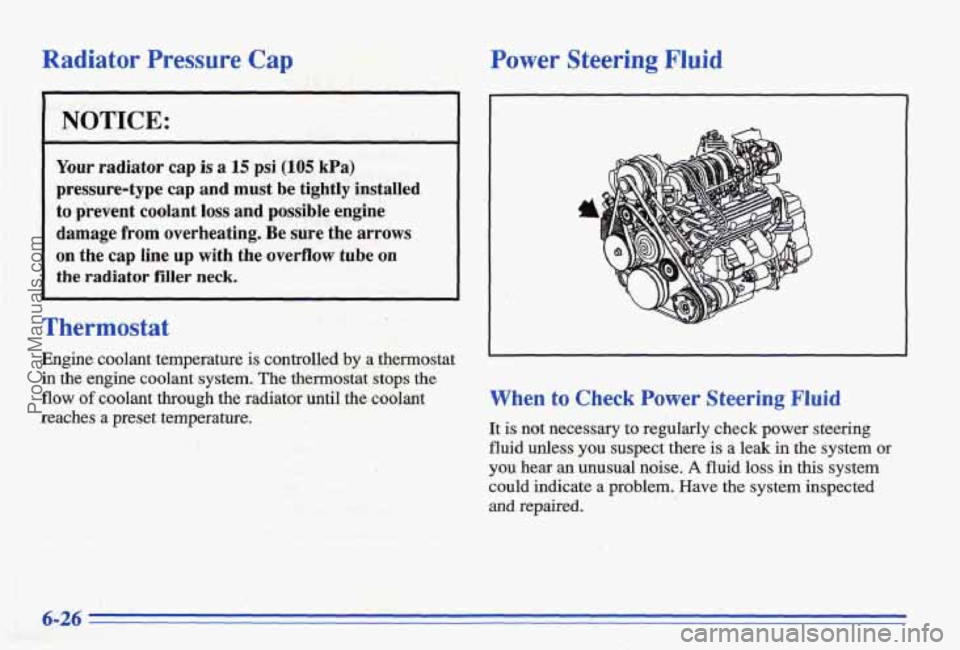
Radiator Pressure Cap
NOTICE:
Your radiator cap is a 15 psi (105 kPa)
pressure-type cap and must be tightly installed
to prevent coolant loss and possible engine
damage from overheating. Be sure the arrows
on the cap line up with the overflow tube on
the radiator filler neck.
1 I --$,. .: :; ' -%.Thermostat .
Engine coolant temperature is controlled by a thermostat
in the engine coolaxit system. The thermostat stops the
flow of coolant through the radiator until the coolant
reaches a preset temperature.
Power Steering Fluid
When to Check Power Steering Fluid
It is not necessary to regularly check power steering
fluid unless you suspect there is a leak in the system or
you hear
an unusual noise. A fluid loss in this system
could indicate
a problem. Have the system inspected
and repaired.
6-26
ProCarManuals.com
Page 272 of 387
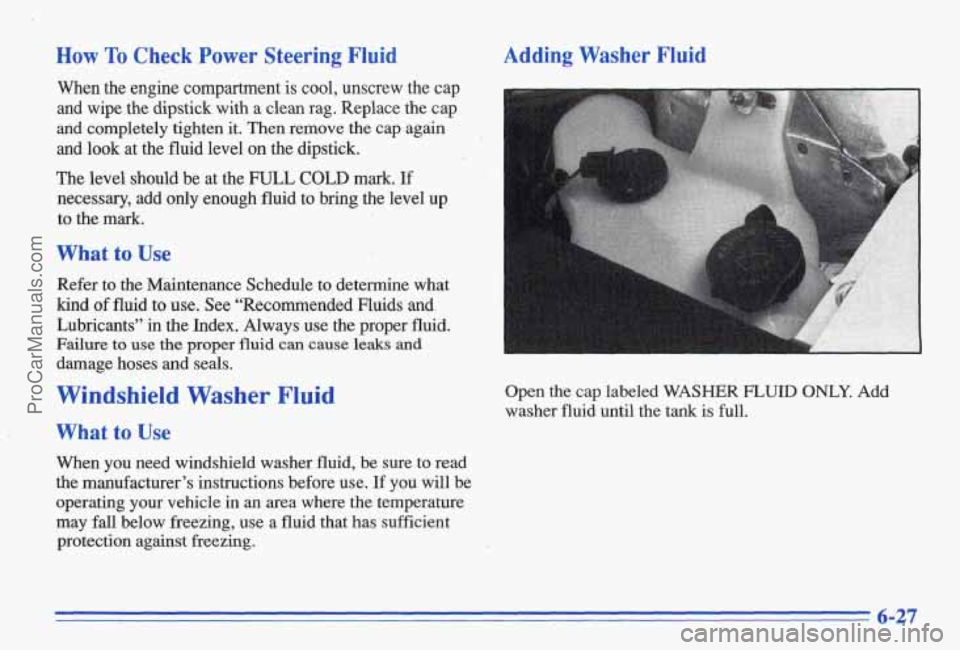
How To Check Power Steering Fluid
When the engine compartment is cool, unscrew the cap
and wipe the dipstick with a clean rag. Replace the cap
and completely tighten it. Then remove the cap again
and look at the fluid level
on the dipstick.
The level should be at the
FULL COLD mark. If
necessary, add only enough fluid to bring the level up
to the
mark.
What to Use
Refer to the Maintenance Schedule to determine what
kind of fluid to use. See “Recommended Fluids and
Lubricants”
in the Index. Always use the proper fluid.
Failure to use the proper fluid can cause leaks and
dam’age hoses and seals.
Windshield Washer Fluid
What to Use
When you need windshield washer fluid, be sure to read
the manufacturer’s instructions before use.
If you will be
operating your vehicle
in an area where the temperature
may
fall below freezing, use a fluid that has sufficient
protection
against freezing.
Adding Washer Fluid
Open the cap labeled WASHER FLUID ONLY Add
washer fluid until the tank
is full.
6-27
ProCarManuals.com
Page 312 of 387
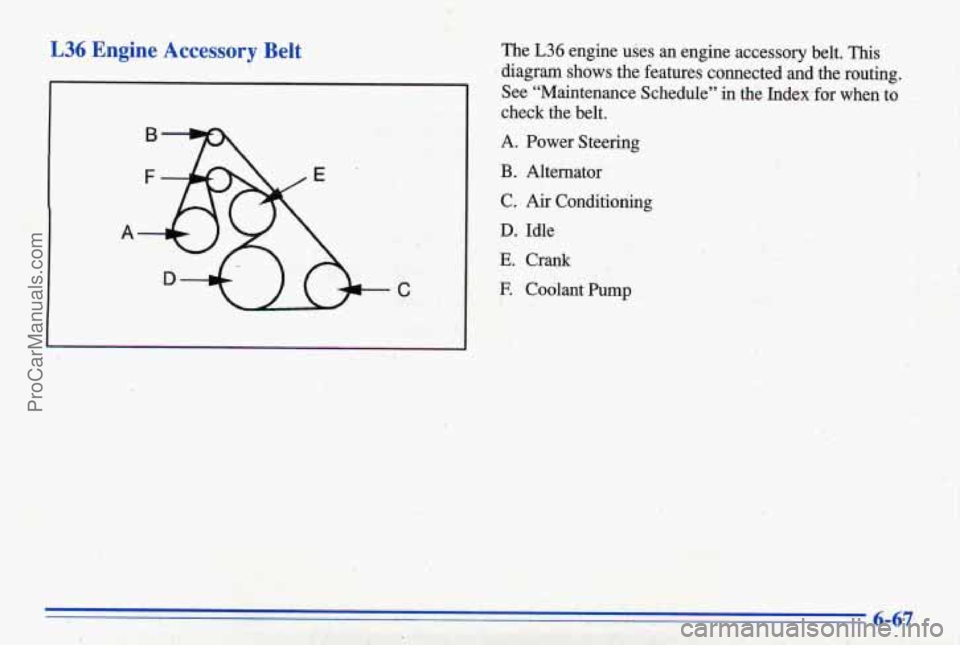
L36 Engine Accessory Belt
C
The L36 engine uses an engine accessory belt. This
diagram shows the features connected and the routing.
See “Maintenance Schedule”
in the Index for when to
check the belt.
A.
B.
C.
D.
E.
E
Power Steering
Alternator
Air Conditioning
Idle
Crank
Coolant
Pump
6-67
ProCarManuals.com
Page 313 of 387
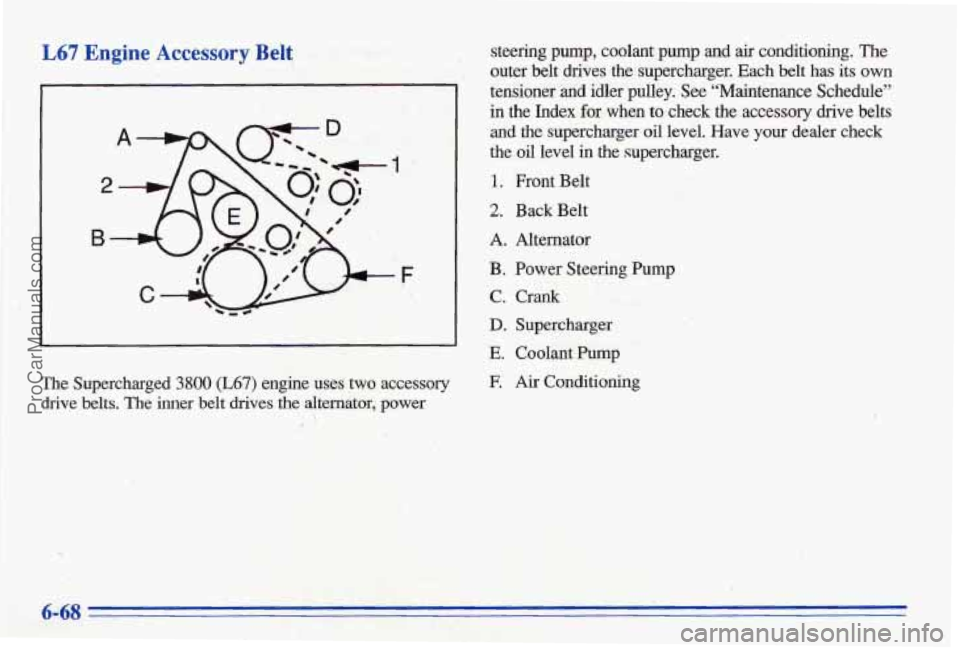
L67 Engine Accessory Belt
The Supercharged 3800 (L67) engine uses two accessory
drive
belts. The inner belt drives the alternator, power steering
pump, coolant pump and air conditioning. The
outer belt drives the supercharger, Each belt has its
own
tensioner and idler pulley. See “Maintenance Schedule”
in the Index for when to check the accessory drive belts
and the supercharger oil level. Have your dealer check
the oil level in the supercharger.
1. Front Belt
2. Back Belt
A. Alternator
B. Power Steering Pump
C. Crank
D. Supercharger
E. Coolant Pump
E Air Conditioning
ProCarManuals.com
Page 355 of 387
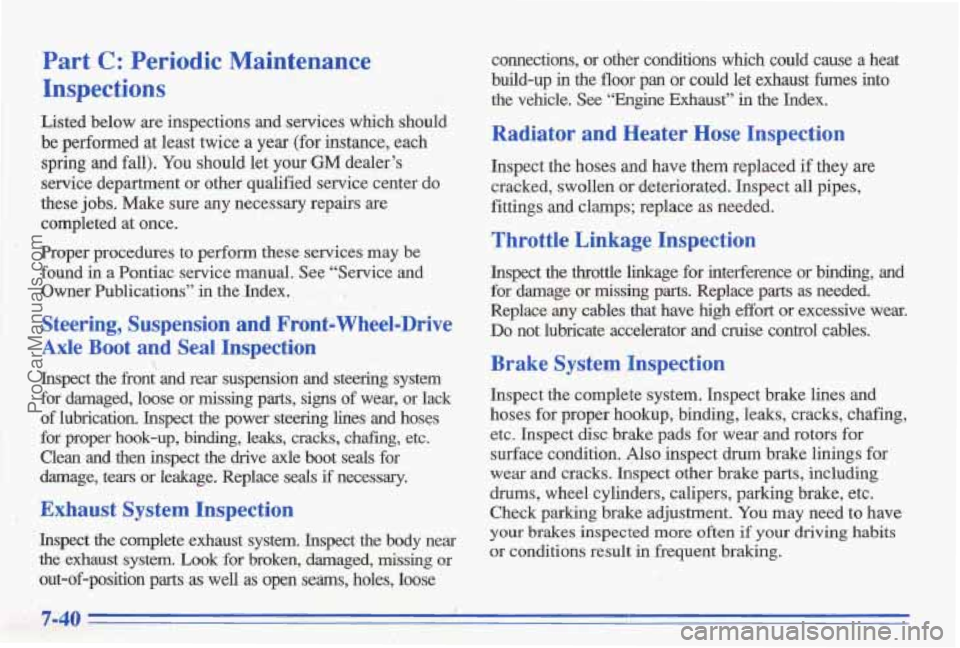
Part C: Periodic Maintenance
Inspections
Listed below are iqspections and services which should
be performed at least twice
a year (for instance, each
spring and fall). You should let your GM dealer’s
service depkent or other qualified service center do
these jobs. Make sure any necessary repairs
are
completed at once.
Proper procedures to perform these services may be
found in a Pontiac service manual. See “Service and
Owner Publications” in the Index.
Steering, Suspension and Front- Wheel-Drive
Axle Boot and Seal Inspection
Inspect the front and rear suspension and steering system
for damaged, loose or missing parts,
signs of we&, or lack
of lubrication. Inspect the power steering hs d hoses
for proper hook-up, binding, leaks, cracks, chafing,
etc.
Clean and then inspect the drive axle boot seals for
damage, tears or leakage. Replace seals if necessary.
..-
,-’; .. :-: : :I . -. :;Exhaust System Inspe,ction
3 ,.
.’Inspect the complete exhaust system. Inspect the body near
the exhaust system. Look for broken, damaged, missing or
out-of-position parts as well as open seams, holes, loose
_.
connections, or other conditions which could cause a heat
build-up
in the floor pan or could let exhaust fumes into
the vehicle.
See “Engine Exhaust’’ in the Index.
Radiator and Heater Hose Inspection
Inspect the hoses and have them replaced if they are
cracked, swollen or deteriorated. Inspect all pipes,
fittings and clamps; replace as needed.
Throttle Linkage Inspection
Inspect the throttle Wage for interference or binding, and
for damage or missing parts. Replace parts as needed.
Replace any cables that have high effort or excessive wear.
Do not lubricate accelerator and cruise control cables.
Brake System Inspection
Inspect the complete system. Inspect brake lines and
hoses’ for proper hookup, binding, leaks, cracks, chafing,
etc. Inspect disc brake pads for wear
and rotors for
surface condition.
Also inspect drum brake linings for
wear and cracks. Inspect other brake
pans, including
drums, wheel cylinders, calipers, parking brake, etc.
Check pvking brake adjustment. You may need to have
your brakes inspected more often if your cjriving habits
or conditions result in frequent braking.
ProCarManuals.com
Page 356 of 387
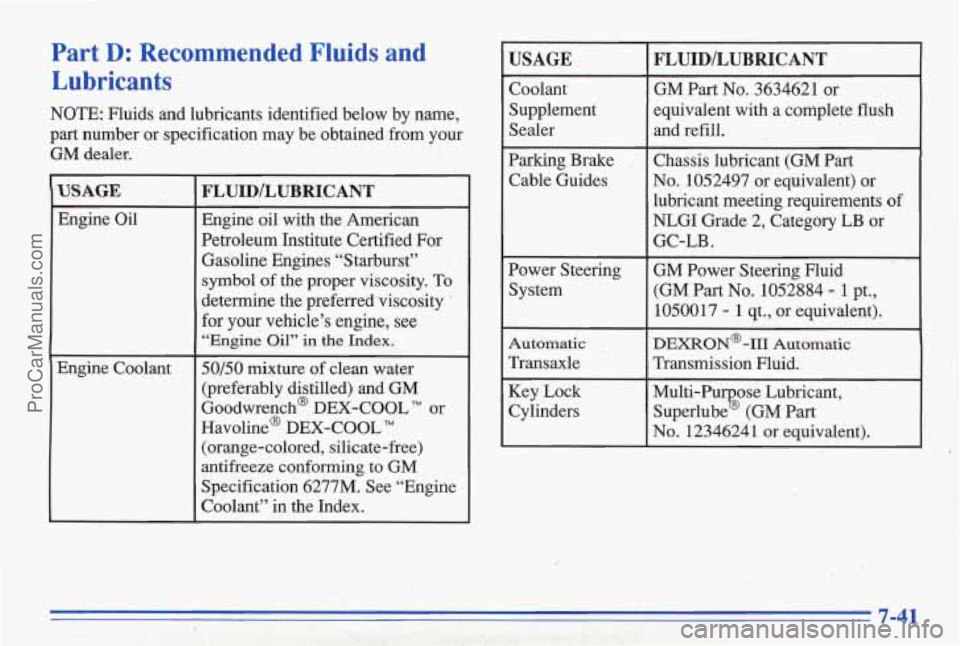
Part D: Recommended Fluids and
Lubricants
NOTE: Fluids and lubricants identified below by name,
part number or specification may be obtained from your
GM dealer.
USAGE
Engine Oil
Engine Coolant
I
FLUID/LUBRICANT
Engine oil with the American
Petroleum Institute Certified For
Gasoline Engines
“S tarburst”
symbol of the proper viscosity.
To
determine the preferred’viscosity .
for your vehicle’s engine, see
‘‘Engine Oil” in the Index.
50/50 mixture of clean water
(preferably distilled) and GM
Goodwrench@ DEX-COOL
or
Havoline’ DEX-COOL TM
(orange-colored, silicate-free)
antifreeze conforming to
GM
Specification 6277M. See “Engine
Coolant” in the Index.
1 ’ ’. ’ rl ~. - , .--. ,
- -L
USAGE
Coolant
Supplement
Sealer
Parking Brake Cable Guides
Power Steering System
Automatic
Transaxle
Key Lock Cylinders
FLUID/LUBRICANT
GM Part No. 3634621 or
equivalent with a complete flush and refill.
Chassis lubricant (GM Part
No. 1052497 or equivalent) or
lubricant meeting requirements of
NLGI Grade 2, Category LB or
GM Power Steering Fluid
1050017 - 1 st., or equivalent).
DEXRON@ -III Automatic
Transmission Fluid.
Multi-Pu ose Lubricant,
Superlube
%I (GM Part
No. 12344241 or equivalent).
GC-LB.
L’
(GM
Part NO. 1052884 - 1 Pt.,
7-41
ProCarManuals.com